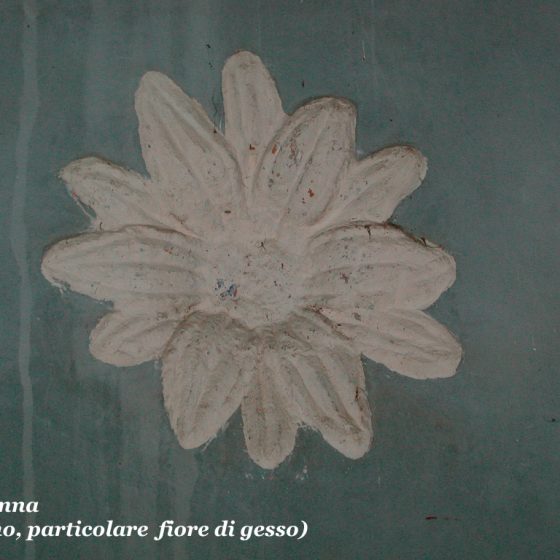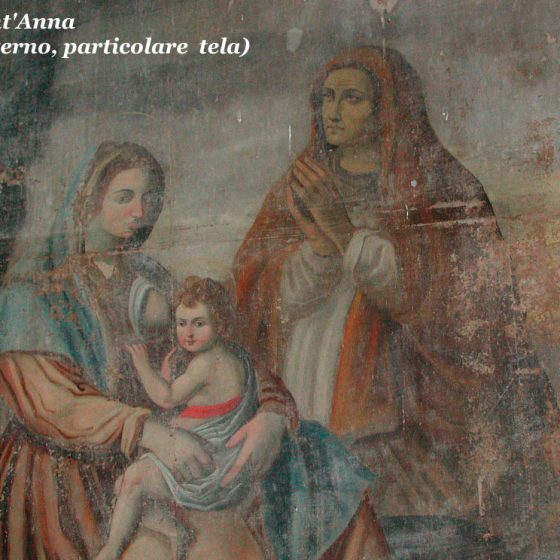Questa piccola chiesa si trova a sud sud est dell’abitato di San Lorenzo, lungo una strada secondaria che conduce a Piè di Beroide (comune di Spoleto).
Ancora una volta apriamo l’Historia … di Trevi di Durastante Natalucci e leggiamo: «[…] la chiesa di S.Anna, non lungi al alveo, volgarmente cognominata S.Enna e S.Avenna, … dalle donne [che] vi concorrono, anche da lontani luoghi, o per avere il latte o per sfuggire il male nelle mammelle, raccomandandosi alla santa, anzi spargendo il latte dalla zinna nella pietra contigua al altare dove è scolpita la rosa – nonostante le replicate proibizioni de’ vescovi – per essere loro grande la speranza di conseguirne la grazia ed averne sempre l’intento.»
La chiesina è dedicata alla santa protettrice delle partorienti.
La tradizione ricorda questo luogo di culto come particolarmente frequentato dalle coppie senza figli.
Queste si recavano presso l’edificio a pregare per l’arrivo del sospirato erede.
Si nascondevano, quindi, tra le canne e le canape, dove trovavano un luogo di suggestione intimo e propiziatorio, con un incanto certo maggiore di una casa piccola e magari sovraffollata.
Nella chiesa si recavano anche le puerpere che non riuscivano ad avere latte sufficiente per sfamare il proprio bambino.
In questo caso per assicurarsi la discesa del latte, appoggiavano la mammella su una forma di gesso riproducente un fiore (rosa o margherita), attualmente inserita nella parete di destra dell’edificio.
Le neo-mamme che, viceversa, avevano abbondanza di latte, usavano comunque recarsi nella chiesa di Sant’Anna per versare alcune gocce del bianco liquido materno sul pavimento, nella speranza che tale atto fosse propiziatorio per le donne meno fortunate.
Simbolismo antico, retaggio di un passato in cui i bambini erano una benedizione per l’intera comunità e ogni evento importante, primo fra tutti la maternità, era vissuto collettivamente.
Ma anche percorso, tra il religioso ed il pagano, per allontanare da se stesse il potere malefico (il malocchio, le malie) che si supponeva potesse venire da donne sterili, o in ogni modo meno fortunate in fatto di prole, e per questo, forse, invidiose di quelle feconde.
In un percorso mistico-propiziatorio, potremmo unire la visita della chiesa di Sant’Anna a quella di Santa Maria Pietrarossa, con l’adiacente pozzo di San Giovanni, per ricordare come a queste Sante donne abbiano sempre fatto appello le comuni mortali in difficoltà, riconoscendole come divinità taumaturgiche in un contesto sociale-sanitario in cui il ricorso al mondo magico-religioso era forse l’ultima, se non l’unica, speranza di guarigione e salvezza.
TREVI, SAN LORENZO, CHURCH OF SANT'ANNA `{`SAINT ANNE`}`
This small church is located south, south-east of the little town of San Lorenzo, along a secondary road leading to Piè di Beroide (municipality of Spoleto).
Once again we open the book ‘Historia … di Trevi’ written by Durastante Natalucci and so we read (in an ancient Italian, not easily translatable): «[…] the church of St.Anne, not far from the river bed, popularly known as St. Anne or St. Avenna, by the women who lived there. Avenna, … by the women [who] flock there, even from far away places, either to have milk or to escape the evil in their breasts, recommending themselves to the saint, or rather sprinkling the milk from the ‘zinna’ in the stone next to the altar where the rose is carved – in spite of the repeated prohibitions of the bishops – so that their hope of obtaining the grace and always having the means to do so is great […]».
The church is dedicated to the patron saint of women in child-bearing.
Tradition’s it that this place of worship was particularly popular with childless couples.
They would come to the building to pray for the expected heir.
They would then hide among the reeds and the canopies, where they would find an intimate and propitiatory place of suggestion, certainly more charming than a small and perhaps overcrowded house.
The church was also used by women who had just had a baby and did not have enough milk to feed it.
In this case, in order to ensure that the milk dropped, they would rest their breasts on a plaster form reproducing a flower (rose or daisy), now incorporated in the right-hand wall of the building.
New expectant mothers who, on the other hand, had an abundance of milk, used to go to St Anne’s Church to pour a few drops of the white maternal liquid onto the floor, in the hope that this act would be propitiatory for less fortunate women.
An ancient symbolism, the legacy of a past in which children were a blessing for the entire community and every important event, above all motherhood, was experienced collectively. But it was also an ideal and symbolic itinerary, between the religious and the pagan,
to ward off the presumed evil power (the so-called evil eye, or malia) that was supposed to derive from infertile women or those less fortunate in terms of offspring.
In a real journey, between the mystical and the propitiatory, we could join the visit to the church of St. Anne to that of St. Mary of Pietrarossa, with the well of St. John, to remember how ordinary people in trouble have always appealed to these sainted Women, recognising them as thaumaturgic divinities in a social-health context in which recourse to the magical-religious world was perhaps the last, if not the only, hope of healing and salvation.
The translation of this post is edited by Patrizia ANTONELLI


